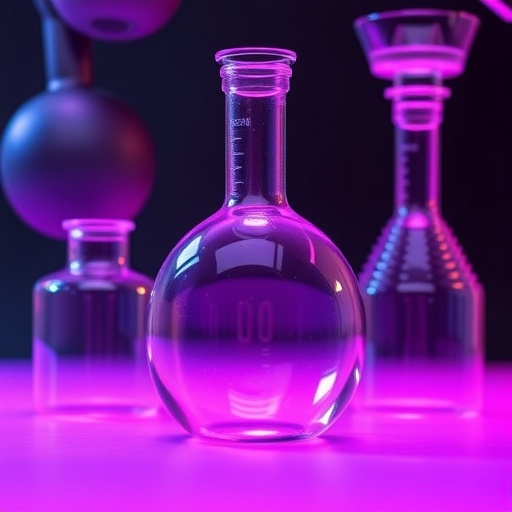In a transformative advancement for solar-driven chemical synthesis, a research team led by Professor Yuchao Zhang at the Institute of Chemistry, Chinese Academy of Sciences, has engineered an innovative photoelectrocatalytic system that significantly enhances the efficiency and sustainability of styrene epoxidation. This process is pivotal for producing essential polymer intermediates and fine chemicals but traditionally suffers from reliance on hazardous oxidants and limited reaction efficiencies. Through the strategic integration of gold nanoparticles on NiCo2O4 nanoneedles, the newly developed Au/NiCo2O4 photoanode system harnesses sunlight and plasmonic photothermal effects to drive epoxidation with unprecedented performance metrics.
Styrene epoxidation, a cornerstone reaction in industrial chemistry, often grapples with challenges like poor selectivity and the hazardous nature of oxidants used in conventional methods. The breakthrough reported involves a sophisticated plasmonic platform where localized surface plasmon resonance (LSPR) of gold nanoparticles plays a decisive role by absorbing visible light and
converting it directly into localized heat. This photothermal effect accelerates the chemical dynamics on the photoanode surface, leading to remarkable reaction conversion and selectivity under mild conditions. The NiCo2O4 component, structured as nanoneedles, acts synergistically by providing a high surface area catalytic scaffold, enhancing charge separation, and supporting effective photothermal conversion.
Under visible light irradiation, the Au/NiCo2O4 photoanodes demonstrate a styrene conversion rate of 94%, epoxide selectivity of 98%, and a Faradaic efficiency as high as 96%. These figures highlight the superior catalytic prowess of the system compared to traditional approaches. The reaction is powered by a dual mechanism: the plasmon-induced photothermal effect that locally elevates the temperature, thereby accelerating bromide oxidation, and the efficient catalytic surface that facilitates bromine radical generation—a critical intermediate species driving the epoxidation process.
Detailed mechanistic insights were gleaned through advanced characterization techniques. Isotope labeling experiments conclusively established water as the sole oxygen source in the epoxidation, indicating an environmentally benign reaction pathway without the adventitious introduction of molecular oxygen or other oxidants. Scanning electrochemical microscopy (SECM) mapped the spatial distribution of reactive species, while infrared thermography confirmed a localized temperature increase on the photoanode surface under illumination, exponentially enhancing mass transport phenomena and accelerating reaction kinetics.
The interplay between plasmonic heating and catalytic function in the Au/NiCo2O4 system underpins a paradigm shift in solar chemical engineering. Unlike bulk heating methods, the localized heating intrinsic to LSPR leads to more efficient energy utilization and minimizes thermal losses. This ensures the reaction proceeds more swiftly and selectively, with reduced side-reactions. The photothermal effect also creates temperature gradients that enhance convective mass transport, thereby overcoming diffusion limitations commonly encountered in epoxidation reactions.
Operational stability is a hallmark of this emergent technology. The photoanodes retained their structural integrity and catalytic performance after prolonged exposure to continuous illumination and electrochemical conditions for over 100 hours. Such robustness is critical for potential industrial translation, where long-term catalyst durability is paramount. Electron microscopy and spectroscopic analyses post-reaction revealed no significant morphological or compositional degradation, underscoring the resilience of the Au/NiCo2O4 architecture.
This study importantly situates itself at the convergence of material science, photochemistry, and catalysis, illustrating a powerful strategy by which the photophysical properties of plasmonic metals can be harnessed to drive and enhance complex chemical transformations. By leveraging sunlight—a clean, renewable energy source—the approach aligns with global sustainability imperatives, circumventing the need for toxic oxidants and harsh reaction conditions, common drawbacks in conventional epoxidation techniques.
The implications extend beyond styrene; the tailored photothermal catalytic system holds potential applicability for a broad spectrum of light-driven organic transformations and oxidation reactions. The modularity of the NiCo2O4 platform allows for customization with various plasmonic metals, potentially enabling the tuning of light absorption profiles and thermal effects to match specific target reactions, thus broadening the scope of solar-to-chemical conversion technologies.
Moreover, this interdisciplinary research adeptly combines experimental electrochemical methodologies with precise thermographic and microscopic techniques, providing a comprehensive understanding of the synergistic effects at the nanoscale. This holistic approach enables the rational design of catalysts where both electronic and thermal parameters can be fine-tuned for optimal performance, heralding a new era in photoelectrocatalysis.
In summary, the Au/NiCo2O4 photoanode represents a significant leap forward in the sustainable production of styrene oxide. The combination of plasmonic photothermal heating with efficient catalytic function under visible light illumination presents a compelling blueprint for future green chemistry processes. As industry increasingly seeks cleaner and more energy-efficient methods, systems like this could become foundational technologies in the chemical manufacturing landscape, epitomizing the practical integration of nanotechnology and renewable energy.
This pioneering work not only highlights the transformative power of plasmonic catalysts in photoelectrochemical applications but also underscores the vast untapped potential of solar-driven chemical synthesis. By continuously advancing the understanding and control of light–matter interactions at the nanoscale, such research paves the way for scalable, eco-friendly, and economically viable alternatives to traditional chemical processes, forging new frontiers in sustainable industrial chemistry.
Subject of Research: Photoelectrocatalytic styrene epoxidation leveraging plasmonic photothermal effects on Au/NiCo2O4 photoanodes.
Article Title: Plasmon-Assisted Photothermal Catalysis for Efficient Styrene Epoxidation on Au/NiCo2O4 Photoanodes.
Web References: DOI: 10.1007/s11426-025-2849-5
Image Credits: ©Science China Press
Keywords
Photoelectrocatalysis, Plasmonic nanoparticles, Styrene epoxidation, Photothermal effect, Au/NiCo2O4, Localized surface plasmon resonance, Solar chemical synthesis, Sustainable catalysis, Faradaic efficiency, Bromide oxidation, Renewable energy, Nanomaterials





